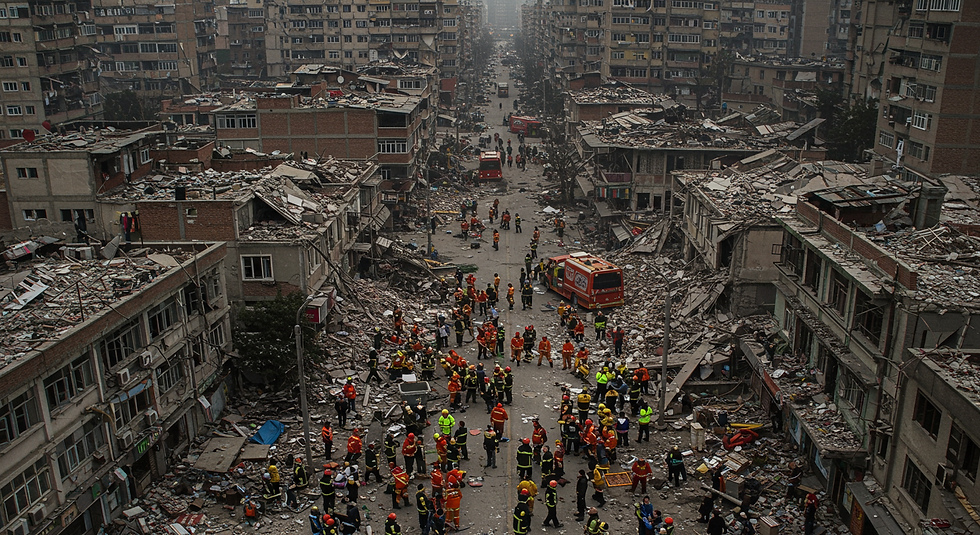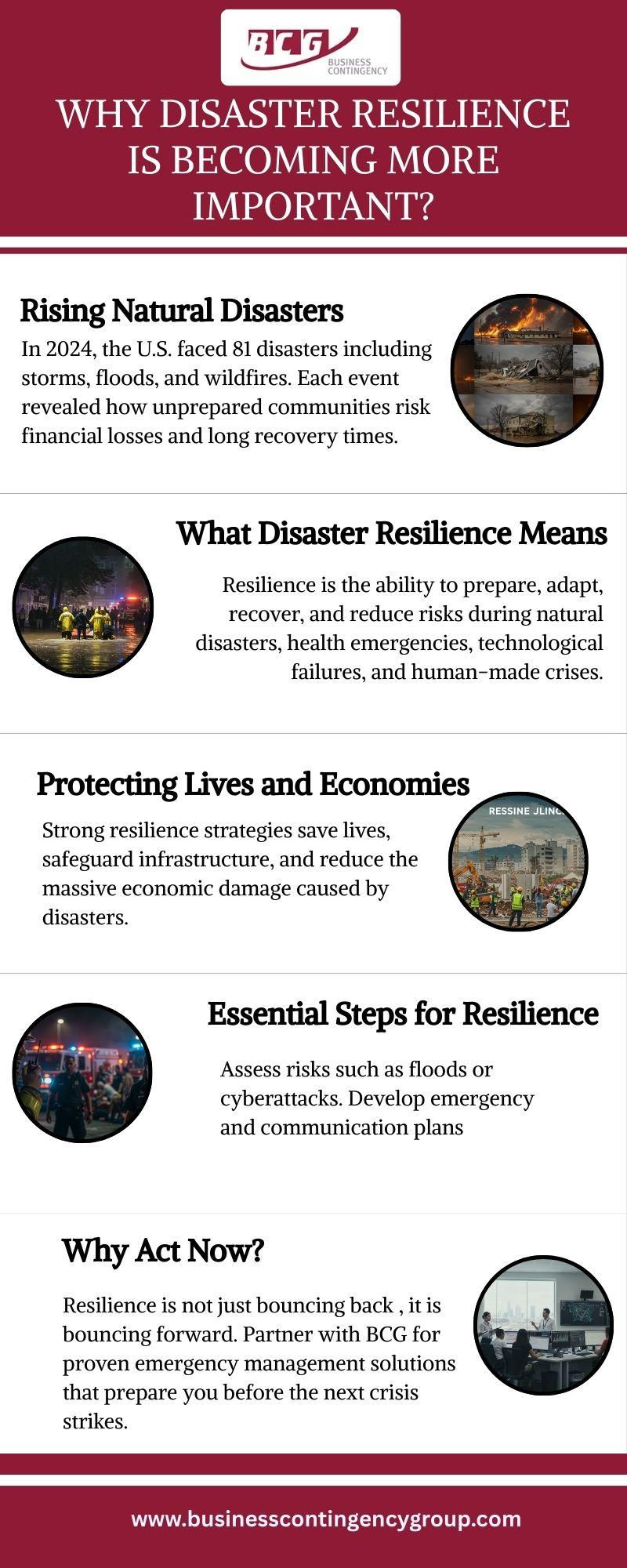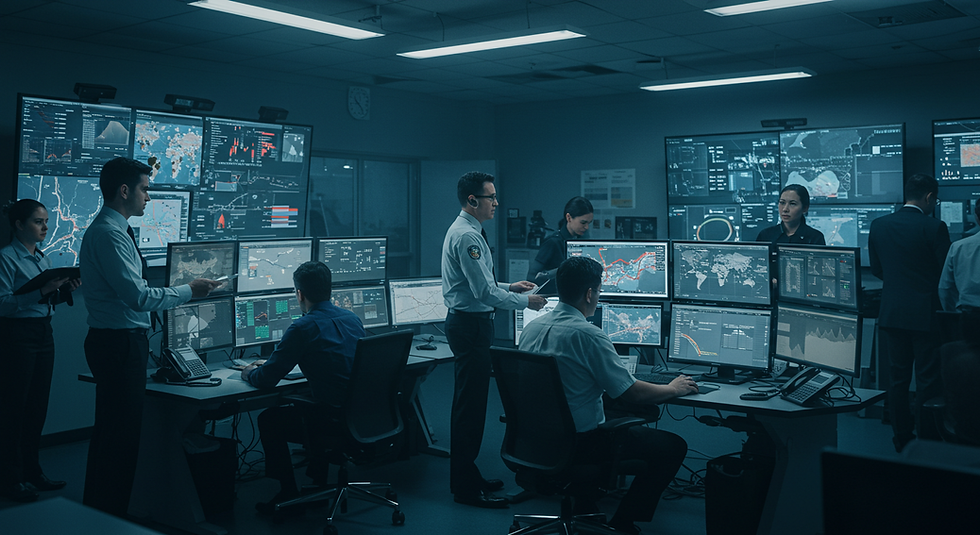Why is disaster resilience becoming more important?
- rebekahh84
- Sep 3
- 4 min read
Updated: Sep 25

81 natural disasters occurred in 2024 in the United States. Many of them were caused by severe convective storms, wildfires, heat waves, drought, floods, and flash floods.
Natural calamities can strike unexpectedly and disrupt businesses and daily life. Many organizations and individuals are unprepared for these events and can lead to financial losses and long recovery times.
Even the even minor disruptions can escalate into major crises without proper disaster resilience. Businesses may fail to plan for emergencies and may face reputational damage and long term setbacks.
The increasing frequency and severity of ignoring disasters can be an expensive mistake. And that is why disaster resilience has become important.
Are you ready to partner with an emergency management consulting company that can strengthen your preparedness before the next crisis strikes? Contact BCG today.
What is disaster resilience?
Disaster resilience is ability of any organization to prepare and recover from destructive events like
Natural disasters
Health emergencies
Technological failures
Human-made crises
A resilient system does not just survive a disaster but also helps to minimize damage and maintain essential functions during a crisis. Here are some of the key elements of disaster resilience:
Preparedness: Planning for potential hazards and risks.
Adaptability: Adjusting operations or behavior in response to changing circumstances.
Recovery: Restoring normal functions quickly after a disruption.
Risk mitigation: Reducing vulnerability to future disasters through infrastructure and trainings.
Disaster resilience is about bouncing back stronger and safer after an unexpected event.
What emergency management solutions does your organization have in place to protect people, assets, and operations during unexpected disruptions?
5 Reasons Policymakers Should Prioritize Disaster Resilience
Extreme weather conditions have become more frequent and severe in the country. Planning and investing in disaster resilience helps communities bounce back from these events.
Protect Lives and Public Safety
The one of the most important reason for prioritizing disaster resilience is the protection of human life. Natural disasters like hurricanes, floods and wildfires can cause injuries, fatalities, and long-term health impacts. Policymakers can ensure communities are better prepared to respond to emergencies by investing in resilient infrastructure.

Minimizing Economic Losses
Disasters can have devastating economic consequences. Businesses may close temporarily, and it may also damage the infrastructure, and recovery costs can be enormous. Prioritizing resilience helps reduce these losses through measures such as robust building codes and disaster recovery funds. The resilient communities experience fewer financial setbacks and maintain economic stability even in the face of emergencies.
Ensure Continuity of Essential Services
Many critical services like healthcare, transportation and communication must remain operational during disasters. Policymakers ensure that essential services continue to function even under extreme conditions by investing in disaster resilient systems. This continuity supports prevents cascading failures and helps communities recover more quickly after a crisis.
Strengthening Social Cohesion and Community Trust
Communities that are prepared for disasters experience less panic and disruption during emergencies. When policymakers implement disaster resilience initiatives, they create trust between government authorities and the public. Citizens feel safer knowing that emergency plans and support systems are in place. Strong social cohesion also encourages community participation in preparedness effort to improve resilience.
Adapting to Climate Change and Emerging Threats
Climate change is increasing the frequency and severity of extreme weather events, while technological advancements and global interconnectivity create new vulnerabilities such as cyberattacks and pandemics. Disaster resilience allows policymakers to anticipate and adapt to these evolving threats. Governments can future-proof communities against both current and emerging hazards by integrating climate adaptation and risk management into planning. Policy makers and planners work together to address the threats to the country.
Steps to Improve Disaster Resilience

1. Risk Assessment:
The first step is understanding the risks you face. Find out the potential hazards
such as floods
earthquakes
cyberattacks
Pandemics
A clear risk assessment helps prioritize resources and create targeted action plans.
2. Emergency Planning:
Develop clear response procedures and communication plans. This includes evacuation routes, communication procedures and roles for staff or community members. It is equally important to test these plans regularly through drills and simulations to ensure that people know how to respond under pressure.
3. Strengthen Critical Infrastructure:
Infrastructure resilience is essential to keep vital systems functioning during and after a disaster. Policymakers and businesses should invest in:
Reinforced buildings and flood defenses
Backup power supplies and water systems
Redundant communication networks
This reduces the risk of complete failure when disaster strikes.
4. Build Supply Chain Flexibility
Disaster resilience also depends on supply chain continuity. Strategies include diversifying suppliers, keeping backup inventory and creating alternative transport routes. Flexible supply chains reduce downtime and help maintain service delivery during disruptions.
5. Invest in Training and Awareness
People are the foundation of resilience. Regular training sessions and employee preparedness programs build confidence and knowledge. The collective response is faster and more effective when individuals understand their roles and responsibilities in a crisis.
Conclusion:
Disaster resilience is often seen as a defensive measure, but it can be an opportunity to reimagine how to build and reconnect. Every storm and disruption highlight the capacity to innovate and adapt.
Resilience is not bouncing back but bouncing forward. As we prepare for the next crisis, we shape the future so that communities can thrive whatever may come.
Business continuity has helped manage diverse incidents globally. You cannot afford to take chances, but you need to be ready. We at BCG have been leading experts in emergency management planning and disaster preparedness management to help people recover from all types of disasters and crises.
We have rich experience to make your project successful. If you don’t have a professional plan, then it is the right time to be ready, and we are there with you.




Comments